Menu
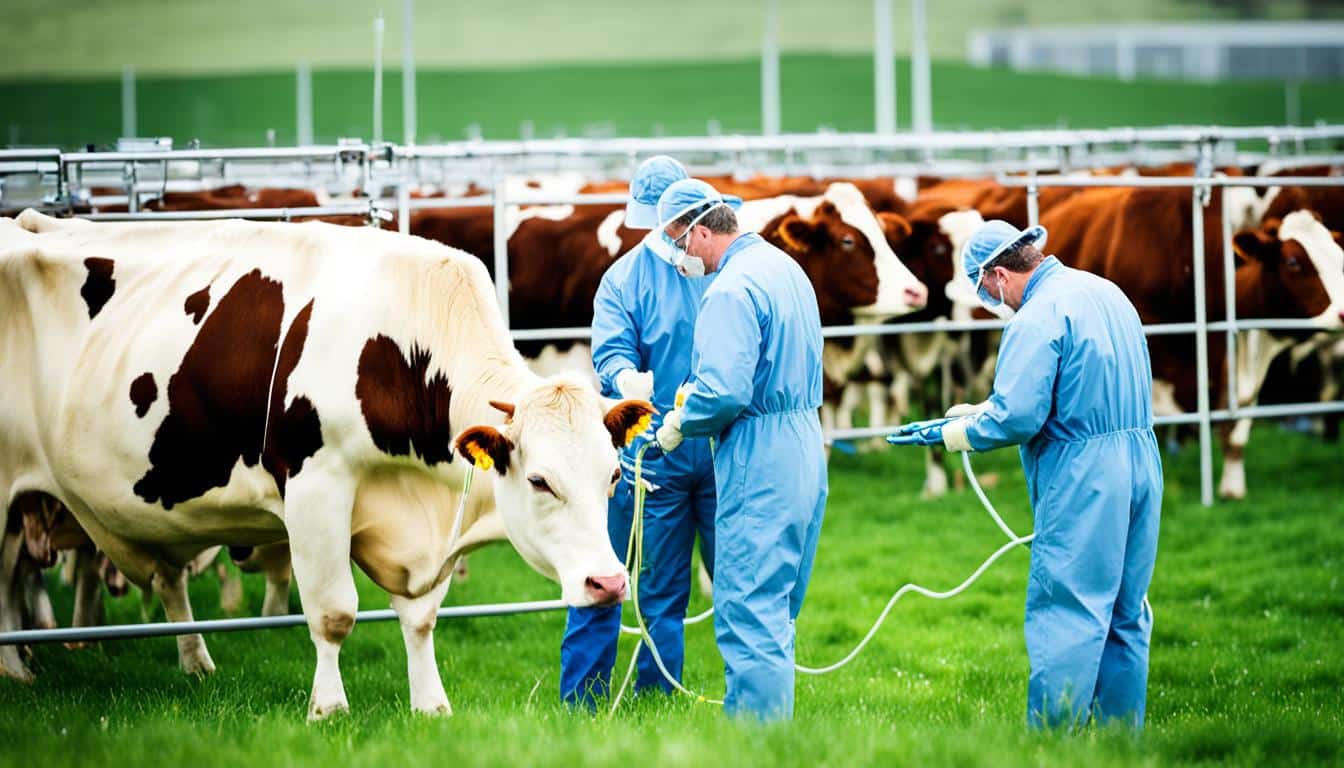
Did you know, on average, people worldwide eat 42.1 kg of meat each year? Developed countries eat nearly twice as much, at 82.9 kg/year. This large difference shows how eating habits vary worldwide. The need for better ways in sustainable animal agriculture is clear. This need pushes efforts in improving biotech livestock breeding.
In places where people consume a lot of meat, there’s a big demand for high-quality protein. To meet this demand, new methods are needed. Biotechnology is key to facing this challenge. It helps us fight pests and diseases, improve how we care for animals, and deal with climate change. At the same time, it aims to reduce the harm agriculture does to the environment. The USDA significantly helps by funding research that brings fast, practical solutions to farmers. Genome editing is becoming essential in this work.
Through genome editing and other biotechnologies, the goal is to create livestock that are stronger and healthier. This can help lessen the damage agriculture does to our planet. But for these advancements to move forward, it’s crucial to have rules and policies that focus on safety and innovation. This way, genetic progress in farming can be both reliable and effective.
Livestock breeding methods have come a long way, from basic techniques to today’s high tech practices. Selective breeding was the start, allowing farmers to pick traits they wanted to enhance. They would choose parent animals for their offspring to be stronger, make more milk, or resist diseases better.
Selective breeding jumped into the world of genetic engineering. This move allowed scientists to put specific genes into animals, changing their traits with incredible accuracy. Now, methods like artificial insemination (AI) and embryo transfer (ET) are common, making breeding much more efficient.
Biotechnology is now key in changing how we breed livestock. Techniques like in-vitro fertilisation (IVF) and cloning have made huge improvements possible. This has led to animals that eat less, stay healthier, and produce more.
There have been big moments from the early days of selective breeding to today’s genetic engineering. Moving over 550,000 cow embryos and releasing animal DNA sequences were early steps. The use of genetic markers and powerful studies show how much breeding has evolved.
We’re also getting the full DNA picture of animals like pigs, goats, and sheep. This work is all about improving how much and how well they produce. It’s pointing the way to animals with natural defences against diseases and greater overall productivity.
| Category | Consumption |
|---|---|
| Average Global Meat Consumption | 42.1 kg/year |
| Meat Consumption in Developed Countries | 82.9 kg/year |
| Meat Consumption in Developing Countries | 31.1 kg/year |
| Global Milk Consumption per Person | 108 kg/year |
| FAO Recommended Daily Milk Consumption | 200 kg/year |
New biotech tools are changing how we breed animals. Using methods like genome editing and AI, we can quickly improve livestock. This means they can be more productive, healthier, and happier.
At the forefront is CRISPR genome editing. It lets scientists change animal DNA very precisely, adding helpful traits. For example, it can help spot and stop genetic diseases, making herds healthier. The International Embryo Transfer Society notes big leaps in moving embryos of cattle, sheep, and goats worldwide, thanks to CRISPR and its relatives.
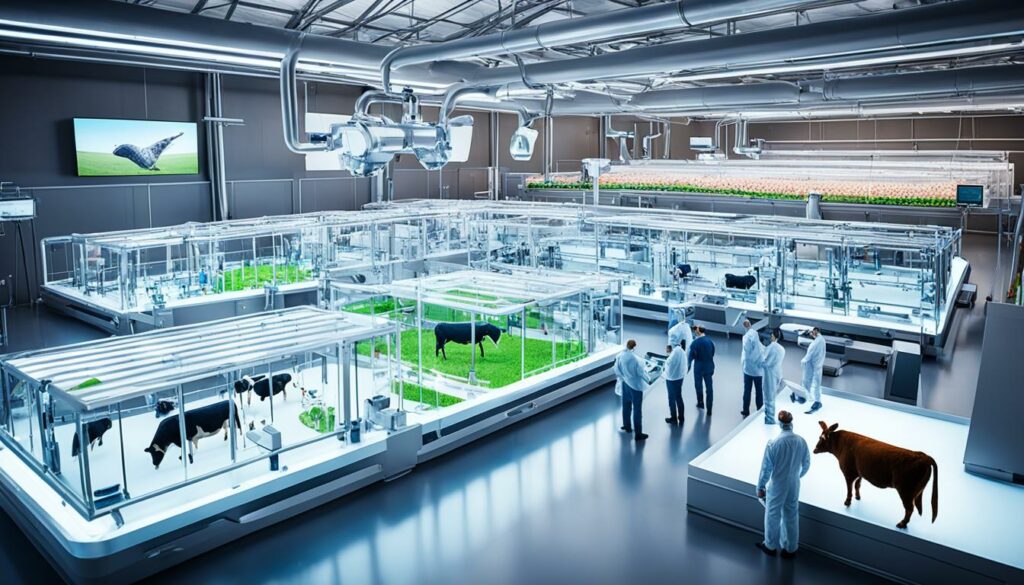
Looking globally, each person eats about 42.1 kg of meat a year. This number is higher in rich countries at 82.9 kg/year but lower in poorer ones at 31.1 kg/year. Genomic editing helps keep up with meat demands by making animals more productive.
Artificial Intelligence (AI) is a big help in picking the best animals for breeding. It sifts through a lot of genetic info to find top candidates. This smart selection boosts the chances of getting the traits we want.
AI works great alongside genome editing like CRISPR. Together, they speed up genetic progress, making animal farming more sustainable. But, to really make the most of these techs, we need people to welcome them and good rules in place.
| Technique | Application | Impact |
|---|---|---|
| CRISPR Genome Editing | DNA modifications | Improved traits in livestock |
| AI in Breeding | Predictive analysis | Optimised breeding outcomes |
Precision breeding combines old and new ways to make livestock better. It uses modern technology to boost animal traits efficiently. This makes farming more productive through careful genetic changes.
It helps animals be healthier and fights off plant diseases. By making livestock more resistant, it tackles issues like food shortages. This effort is important for ensuring there’s enough food for everyone.
It also tackles climate change by creating tough livestock. Using advanced technology and mapping, farmers can control diseases better. Projects like CYBELE are bringing big data together to improve farming.
In Europe, smart farming strategies are improving agriculture. This not only makes farming more efficient but also eco-friendly. The UK and Ireland are leading by using technology to manage soil nutrients and increase yields.
New tech for checking soil moisture and nutrients is changing farming. This wider approach is seen as the start of a new farming era in Europe.
| Aspect | Impact |
|---|---|
| Production Efficiency | Increased through targeted genetic modifications. |
| Animal Health and Welfare | Improved by introducing disease-resistance traits. |
| Climate Change Resilience | Enhanced by breeding stress-resistant livestock. |
| Sustainable Disease Control | Achieved through precision agriculture and geospatial techniques. |
| Soil Nutrient Management | Optimised in the UK and Ireland through advanced technologies. |
Genetic modification in livestock is all about changing an animal’s DNA key parts. This is done to get certain traits. It uses both genetic engineering (GE) and genome editing (GnEd), which lets scientists be very specific in their changes.
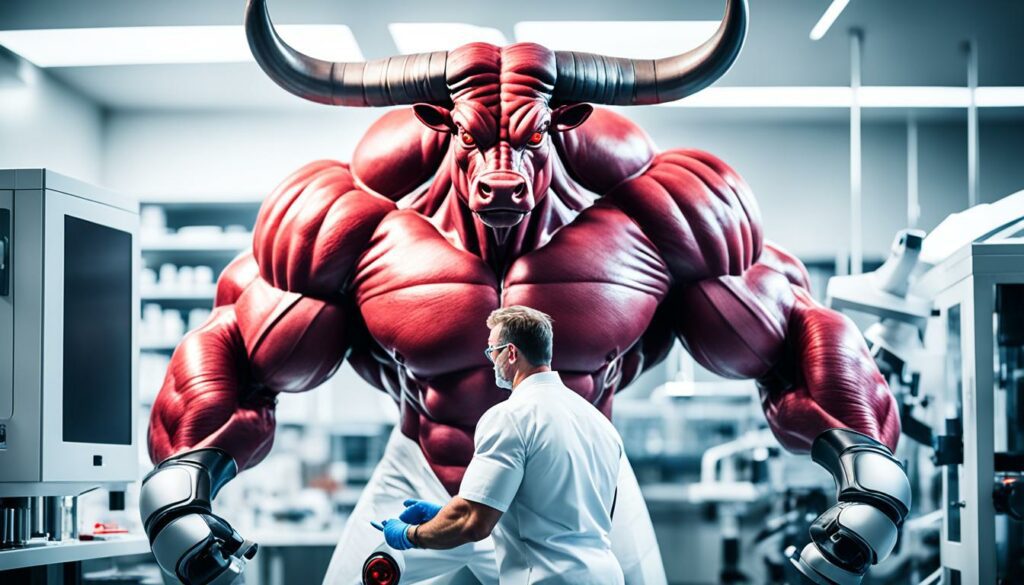
Genetically modified livestock are animals with changed DNA, thanks to biotechnology. For example, the AquAdvantageTM Atlantic salmon grows faster than usual. Some examples like “GloFish” and cloned pets are famous. But, most modified animals are used in research. In farming, animals like pigs and sheep may be engineered to grow bigger. This aims to make them more productive.
Using genetically modified animals has many benefits in farming, like creating disease-resistant breeds or improving the food’s quality. The EnviropigTM, for example, helps reduce pollution by processing phosphorus in its diet. But, using these animals raises questions about ethics. People worry about the animals’ well-being, the environment, and if it’s safe to eat the food they produce. Dealing with these concerns is a big part of using this technology correctly, following ethical and safety rules.
Editing the DNA of livestock is changing how we farm animals. With tools like CRISPR, scientists can make specific changes in animal genes. This makes animals grow better or be healthier.
Genome editing is more than just boosting how much meat or milk animals make. It was said in a CABI Agriculture and Bioscience article that got a lot of attention, genome editing helps meet the demand for good protein while fighting off diseases. The research, with an 87 Altmetric score, shows it’s very important.
The USDA, a big player in farming research, is using genome editing too. They’re working on issues that really matter, like making livestock healthier or better at making products. This work is especially needed in hot places, where most of the world’s cattle live, but face challenges.
A study showed that certain types of cattle stay cooler than others. This finding points to how changing their genes can help them survive in heat better. Similar research picked out a specific gene that makes some cattle have smooth, sleek coats.
Changing animals’ DNA can also help us use fewer drugs and chemicals to keep them healthy. This means we get safer food and help the planet too. It’s a big win for everyone.
All these new ways in farming must be safe and fair. The rules around the world are getting updated to make sure of that. As farming techniques get better, so do the animals. This pace of change over 20 years could really transform how we raise animals.
The USDA focuses on improving animal breeding through research and funding. It uses knowledge from 29 different agencies. This helps bring new science to farmers and consumers.
The USDA is working to solve big farming problems, including animal breeding issues. Places like the ARS and NIFA lead in innovation. They use information from the Census of Agriculture and reports like Livestock, Dairy, and Poultry Outlook to support new technology. The Catfish Production Reports and Trout Production Reports give important details for certain livestock areas.
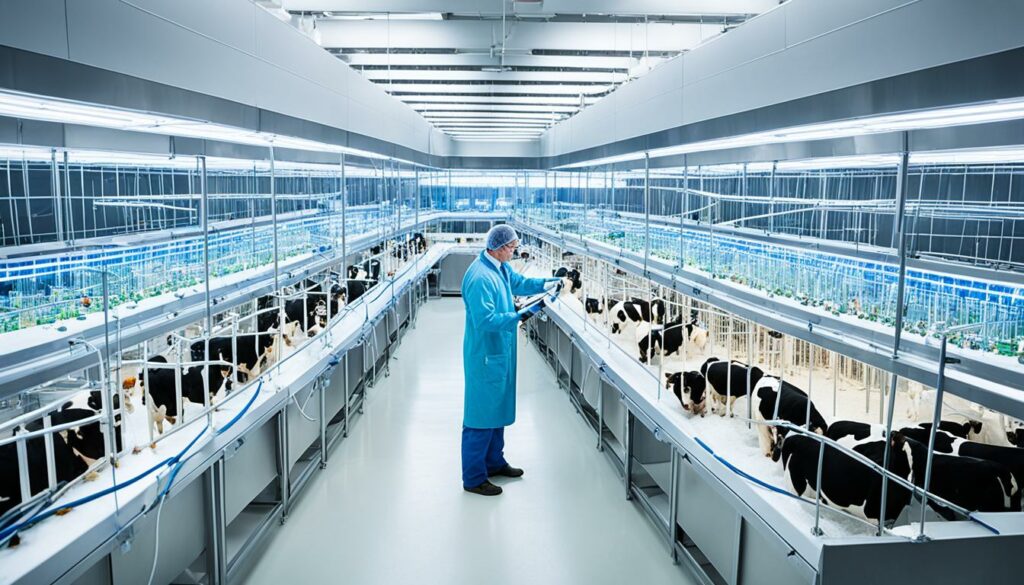
Funding from the USDA goes to various types of animal breeding research. This includes backing for new genome editing like CRISPR. Such innovation is key to making animals healthier and more efficient, helping farms and the environment.
The USDA works closely with those in the field to apply new tech practically. It shares helpful safety and production info, keeping everyone up-to-date. This helps with everything from Ground Beef Safety to Egg production.
Building better food and markets is another goal. By working together, these advances aim to make farming both more productive and eco-friendly. The USDA also provides support for smart land use in cattle and sheep farming.
| USDA Research Agencies | Primary Focus | Data Reports |
|---|---|---|
| Agricultural Research Service (ARS) | Developing solutions to agricultural problems | Census of Agriculture, Livestock, Dairy, and Poultry Outlook |
| National Institute of Food and Agriculture (NIFA) | Funding extramural research on agricultural issues | Catfish Production Reports, Trout Production Reports |
| Food Safety and Inspection Service (FSIS) | Ground Beef and Food Safety information | Monthly Poultry Slaughter, Sheep and Lambs Inventory |
The future of livestock breeding focuses on being sustainable. By 2050, the need for meat and milk will grow by 70–80%. This makes sustainable breeding very important. Such farming helps meet these demands while also reducing harm to our planet.
Sustainable breeding at its heart includes eco-friendly farming. Thanks to biotechnology like genomic selection, we’ve seen big improvements. For example, this tech can make dairy breeding 30-40 times more effective. It helps enhance traits like how efficiently animals turn food into meat.”
Biotechnological tweaks are also cutting down on using resources and releasing less greenhouse gases. Speeding up how animals reproduce is one example. This improves how quickly we can make genetic changes in livestock. The system works well for pigs, cows, and chickens, aligning with our goals for a sustainable future.
To manage the big need for food and protect our environment, we need smart farming methods. A technique known as fixed-time artificial insemination (FTAI) helps boost the number of calves born and improves their quality. In South America, 20-30% of cows benefit from this method each year. This shows the success of sustainable breeding.
Focusing on outdoor grazing is also key. These methods are better for the environment. They help with things like storing carbon in the soil, managing water, and keeping a variety of plants and animals. People who care about animal welfare and the environment prefer these practices.”
Look at the data table below to see how the demand for meat is changing and how efficiently we can produce it:
| Aspect | Data Point |
|---|---|
| Global Meat Consumption (1980-2020) | 29 kg to 43 kg per person |
| Meat Demand Increase (by 2050) | 200% in low and middle-income countries |
| World Cattle Population | Approximately 1.53 billion |
| South America’s Share | 24% of the global cattle population |
| Contribution to Global Beef Demand (2021) | 20% from Brazil, Argentina, Paraguay, and Uruguay |
| Frozen Beef Exportation | 37% of global frozen beef |
This data shows why sustainable breeding is critical. Using eco-friendly methods and advanced technology, we can ensure high productivity with less harm to our world. This is vital for a sustainable future in farming.
The future of biotech livestock is very promising. This is thanks to new technologies like genome editing. These tools help tackle big issues such as food security, sustainability, and climate change. With the world eating more meat than ever, we need livestock that is efficient and tough.
Rich countries eat a lot of meat, about 82.9 kg a year. Poorer countries eat less, 31.1 kg a year. But the global per capita milk consumption is only 108 kg, below the ideal 200 kg. Biotech livestock aims to make meat and milk production better with cutting-edge tools.
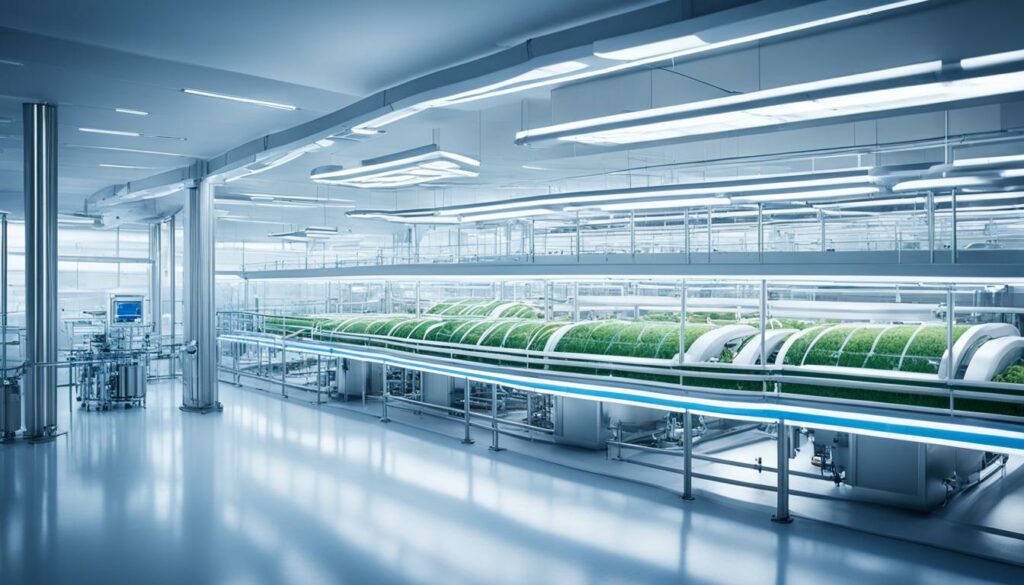
Important livestock like chicken and cows have had their full genetic maps made. Efforts are on to do the same for pigs, goats, and sheep. With DNA tech, we can spot and fix bad genes that cause issues in livestock. This leads to animals that are much stronger and healthier.
Cows are a big focus in biotech. They are key for the huge cattle meat industry. But, animals farming is a big source of greenhouse gas emissions. Cows are a major part of this. So, researchers are using gene editing, like CRISPR, to make cattle better for the environment.
| Year | Embryo Transfers |
|---|---|
| 2004 | 550,000 bovine, 68,000 sheep, 1,000 goat |
Getting meat sustainably is crucial. By 2050, meat production needs to rise 76%. New biotech, like creating cows without horns, has pleased many. It’s making people more open to using tech in animal farming. The hope is that these tech advances will make raising livestock better for our planet.
But we still have big challenges ahead. Like getting the rules right and making people accept gene-edited animals. Brazil is leading the way by using gene editing to shrink its cattle industry’s environmental impact. Gene-edited animals will go through many checks before they come to us, making sure they are safe and work well. This cautious approach is key for the biotech livestock industry’s future, ensuring it grows in the right way.
Biotech livestock breeding is transforming agriculture. It boosts the economy by improving livestock productivity and reducing costs. Also, it enhances food security by making livestock more resilient and productive.
The potential of biotech breeding is huge. Innovations like AI and IVF have made breeding more efficient and cheaper. AI also lowers the risk of disease spread and removes the need for breeding males.
This opens up new market chances and grows the economy within livestock farming.
| Region | Meat Consumption (kg/year) | Milk Consumption (kg/year) |
|---|---|---|
| Global Average | 42.1 | 108 |
| Developed Countries | 82.9 | 108 |
| Developing Countries | 31.1 | 108 |
Global food security is a major concern. Biotech livestock breeding helps meet the growing demand for meat and milk. This is important as the population is set to rise.
Technologies like NFC and molecular markers make breeds more productive. This meets the demand and keeps food supplies stable.
Now, we have the complete genetic makeup of key farm animals. This lets us plan breeding more effectively. Biotech breeding is key for our future agriculture’s success and global food security.
The rules for editing genes in agriculture differ worldwide. This mix of policies affects how fast and in what ways biotechnology is used. To navigate this, it’s crucial to understand current rules and new trends closely.

Countries are focusing more on the traits of products, not just their genetic changes. Canada is a great example. It has approved 123 different crops in 25 years using a science-focused approach. This has boosted innovation. Now, 85-90% of Canada’s canola is herbicide-resistant.
In the US, Canada, Australia, Portugal, and Spain, almost half the world’s GM crops are grown. This focus on what the product does rather than the method might help make global rules more alike. But, different definitions and rules can still create messy situations. The success of CRISPR/Cas, celebrated since 2015 and recently with a Nobel Prize, calls for careful policies. We need rules that support its good parts but also watch out for potential risks, like unwanted genetic changes.
One big challenge for gene editing is the lack of a set of rules that work for everyone. In Europe, very strict rules can slow down the use and acceptance of these innovations. In the US, there’s been debate between two government agencies, causing problems with the approval of gene-edited livestock. This has even led some American scientists to move their work to countries with easier rules.
Despite these challenges, genome editing could really change farming for the better. Using CRISPR/Cas, we could get crops that are healthier and yield more. In 2019-2020, about 190 million hectares of GM crops were grown worldwide. This shows the huge potential. But, for these advances to take off, a global agreement on how to manage gene editing is a must.
| Country | Policy Focus | Key Statistic |
|---|---|---|
| Canada | Science-based regulation | 123 crop varieties approved in 25 years |
| USA | Regulatory divides – FDA vs USDA | 46% share in global GM crop cultivation |
| European Union | Stringent regulations | Concerns over public acceptance |
In animal agriculture, bioengineering is bringing big changes. New methods are making traditional farming smarter. We use genetic engineering and editing to make animals better at what they do. This builds better ways to meet our needs, keeps us safe from diseases, and helps the environment.
One big step is making pigs grow faster with a special gene. It makes them bigger and healthier. Also, changing another gene in animals keeps them safe from a harmful protein. This is a new way to make animals healthier.
Some pigs now produce manure that’s better for the planet because it has less phosphorus. Another cool thing is making spider silk in the milk of special animals. This silk is very strong and can be used in many ways. It shows the power of bioengineering.
Many examples show the good side of using genetics in farming. We have pigs that are rich in omega-3, sheep with very strong wool, and mother pigs that make better milk for their babies. These success stories show that this technology is working.
Here’s a look at some important progress in improving animals through genetics:
| Animal | Genetic Enhancement | Outcome |
|---|---|---|
| Pacific Salmonids | Germline Transgenesis | Extraordinary Growth Performance |
| Pigs | Salivary Phytase Expression | Low-Phosphorus Manure |
| Sheep | Metallothionein-ovine GH Gene | Enhanced Wool Growth |
| Cattle | Prion Protein Suppression | Improved Disease Resistance |
These changes show us what we can do in animal farming using science. Imagine more smart ideas join our farming. This will bless us with better food, stronger animals, and a farming world that takes care of our future.
Genetic engineering in livestock has surged ahead, bringing new breeding possibilities. These advancements boost animal health, productivity, and welfare. Recent breakthroughs are changing the game.
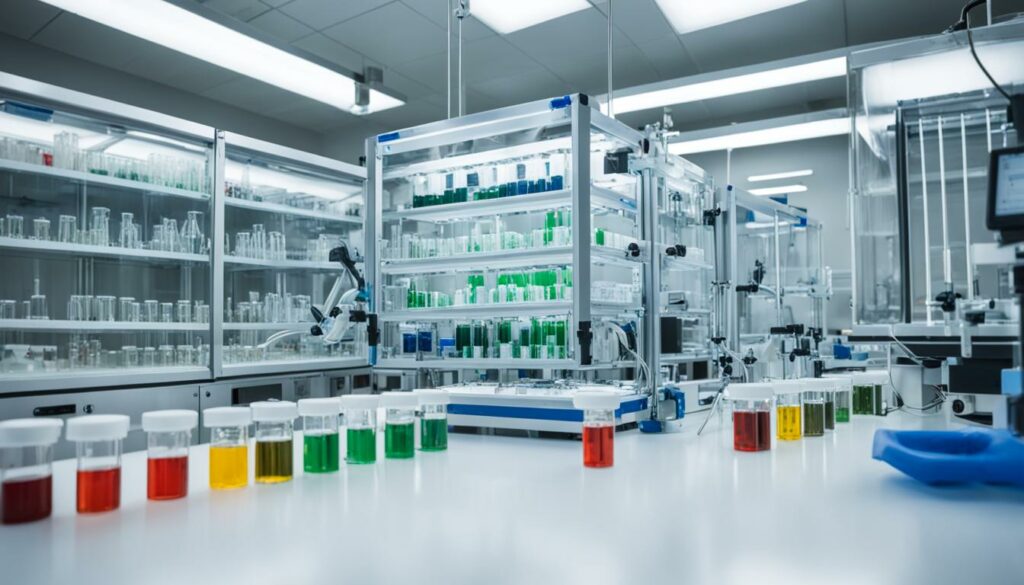
In 2016, scientists achieved something remarkable: gene-edited pigs that resist the PRRSv virus. This breakthrough improves animal health and farm efficiency. It cuts down the need for medicine and makes herds stronger.
Then, in 2022, they made double-muscled sheep and goats using CRISPR/Cas9. This technology is a big win for meat production. It means more meat and better livestock breeding methods.
In 2013, they created live pigs from edited zygotes, showing off CRISPR’s power. This advanced tool helps in achieving precise breeding goals. It’s a big step forward in fighting animal diseases and boosting productivity.
In 2021, Holstein Friesian dairy cattle were edited to have a lighter coat. This tweak helps them cope better with climate change. Such tweaks aid livestock in handling environmental shifts, making farming more sustainable.
| Development | Year | Species | Significance |
|---|---|---|---|
| Resistance to PRRSv | 2016 | Pigs | Reduced medical interventions, increased resilience |
| Double-muscled livestock | 2022 | Sheep and Goats | Higher meat yield, enhanced efficiency |
| Climate adaptation | 2021 | Holstein Friesian Dairy Cattle | Improved environmental adaptability |
These innovations show the huge potential of genetic engineering in livestock. As these methods progress, they will bring more benefits to farming. The future looks bright for agriculture.
Biotechnology is changing the game for animal care. It helps us develop animals that are healthier and happier. This means they get sick less, need less medical help, and live better in their homes.
Thanks to DNA clues, we can find and avoid genetic health issues. This makes sure only the fittest animals become parents. Those babies grow up tougher, needing less medicine, and being less stressed.
This tech also reduces birth problems in livestock. For example, normal calves might have health issues 0.7% of the time. With biotech, this figure goes up but can then come down with early action. So, more animals are born without struggling.
An important goal is to make livestock healthier and more productive. This process ensures they live well, don’t die as much, and reduce the need for emergency care. For example, fewer in vitro calves would need Cesarean births, which is good for everyone.
Looking ahead, more meat and milk will be needed, especially in growing areas. Biotech is key here too. It helps make livestock that can handle more work but in a kinder way.
| Region | Meat Consumption (kg/year) | Milk Consumption (kg/year) |
|---|---|---|
| Developed Countries | 82.9 kg | 150 kg |
| Developing Countries | 31.1 kg | 108 kg |
| Global Average | 42.1 kg | 108 kg |
In the end, biotechnology lets us raise the bar in caring for livestock. It’s more than just more food; it’s a better life for farm animals. This makes farming both successful and kind.
It’s crucial to know how people feel about consumer acceptance of biotech breeding. Plus, it’s important to understand market adoption strategies. This helps make sure that new livestock breeding technologies are a hit. What people think and know affects how much they embrace these new methods.
Research shows there are four kinds of people when it comes to choosing grapes. They care about different things like taste, look, and how they are grown. Some prefer grapes made in traditional ways over new gene editing techniques, even if the new ways are faster, cheaper, and more exact.
Since the 1990s, people have not felt very comfortable with genetically changed crops. This is mainly because they worry about these changes.
Scientists are using CRISPR to change more than just crops. They’re working with animals too. They hope to improve health, quality, and care of these animals. But, many people are unsure about these advances. They trust experts to say if these changes are really safe and useful.

To get more people on board, it’s important to talk openly and include everyone. Sharing how these new methods help animals, the planet, and people is essential. Also, it’s important to listen to what people want and are willing to pay for.
Government rules are key. They can help by making sure everything is clear. This includes how safe new methods are, what they do, and why they’re needed. Doing this can help everyone feel more confident about using new ways in farming.
| Consumer Groups | Willingness to Pay | Preferred Technologies |
|---|---|---|
| Group 1 | Highest for taste and texture improvements | Conventional breeding |
| Group 2 | Moderate for external appearance | Combination of conventional and gene editing |
| Group 3 | Lower for reduced chemical applications | Gene editing |
| Group 4 | Minimal willingness to pay premiums | General preference for non-modified |
In closing, biotech livestock breeding offers great hope for farming’s future. Meat consumption looks very different around the world. Developed areas eat much more, while those in developing regions eat less. We must find new ways to breed animals for meat and milk, as their demand is set to grow.
Biotechnological tools, like genetic markers, help make better livestock. They improve quality and health, but can also carry risks. We must think of the animals’ well-being and the earth’s future too.
Fully mapping out animals’ genomes, like chickens and cows, plus work on pigs, goats, and sheep, opens new doors for breeding. This allows us to choose better, stronger animals for farming. Support from laws and the public is key to making sure biotech breeding meets its full potential.
Biotech livestock breeding uses advanced technologies to improve animals. It involves methods like genome editing to create animals with better qualities. This helps in making animal farming more effective, healthy, and eco-friendly.
Before, farmers bred animals by selecting the best to reproduce. Now, we use genetic tools like CRISPR to make more direct changes. Such techniques have greatly improved over time, making breeding more precise.
Precision breeding uses cutting-edge science to improve animal features. This leads to better productivity and health in animals. It also helps them cope better with a changing climate, which is good for the planet.
Genetically modified animals have had their genes changed to get certain traits. This might mean making them resistant to diseases or increasing what they offer in nutrition. Techniques like GE and genome editing help with these changes.
Genome editing, with CRISPR as a key tool, lets us make very precise changes to animal genes. This cuts down the time it takes to create better animals. Livestock with these improved genes can be healthier and more productive.
The USDA does a lot to support new ways of breeding animals. They fund research and work closely with farmers. Through this work, better farming methods can spread, helping agriculture grow.
Sustainability in breeding means making animals more efficiently without harming the planet. It’s about using less, polluting less, and ensuring animals are well cared for. This is all supported by new biotechnology.
The future of biotech farming looks bright. With tools like genome editing, it could change the way we farm. This new approach could help feed people safely, keep the planet healthy, and adapt to a changing climate.
Biotech farming is not just good for growing food. It also boosts economies and creates new markets. By making animals stronger and more productive, it helps make sure there’s always enough food for everyone.
Rules about genome editing in farming can differ from place to place. Recently, there’s been more focus on what the final product is like, not just how we got there. It’s important to keep rules fair and helpful for farming.
Bioengineering in farms uses science and technology to improve animals for farming. It makes them better at producing food, fighting off sickness, and surviving in different environments. This helps farms be more successful.
Lately, scientists have made big leaps in animal genetic engineering. For instance, pigs that resist certain diseases have been created. Technologies like TALENs and CRISPR are showing great promise for the future of farming.
Biotech can make animals stronger and healthier so they need less medicine. This means they can live better lives while also being more efficient for farming. It’s a win for both the animals and the farmers.
For people to accept biotech farming, they need good information. Knowing the benefits and the ethical issues is key. Showing that these methods lead to better food, happier animals, and a greener planet is important for winning over consumers.